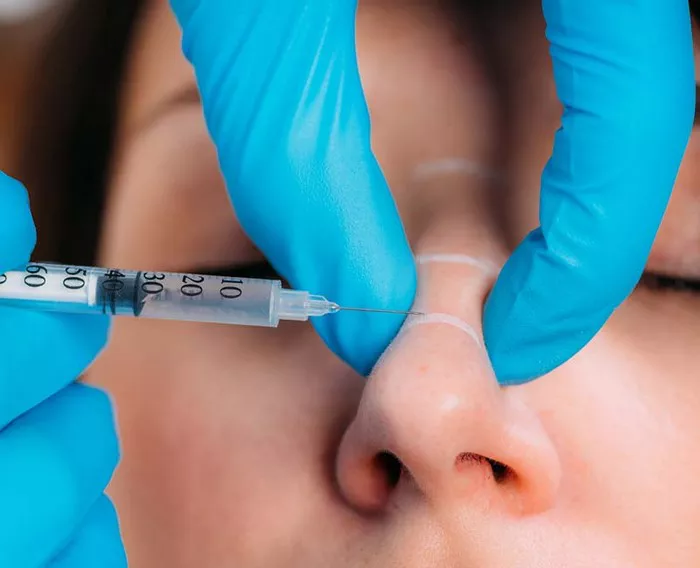Non-surgical rhinoplasty has gained popularity as a minimally invasive alternative to traditional surgical procedures. This innovative technique offers numerous benefits and can effectively address a range of common nose concerns. In this article, we will explore the advantages of non-surgical rhinoplasty and discuss the problems it can effectively solve, providing individuals with a better understanding of this non-invasive option for nasal enhancement.
Non-Surgical Rhinoplasty
Non-surgical rhinoplasty, also known as liquid rhinoplasty or non-surgical nose job, involves the use of injectable dermal fillers to reshape and enhance the appearance of the nose. Unlike traditional surgical rhinoplasty, non-surgical options do not require incisions, general anesthesia, or a lengthy recovery period. Instead, dermal fillers are strategically injected to correct specific concerns and achieve desired results.
Resolving Nasal Irregularities with Non-Surgical Rhinoplasty
Non-surgical rhinoplasty offers a versatile solution for addressing various nasal irregularities. Here are some common problems that can be effectively solved using non-surgical techniques:
Dorsal Hump Correction: A dorsal hump refers to a prominent bump or curvature on the bridge of the nose. Non-surgical rhinoplasty can camouflage the hump by strategically injecting dermal fillers to create a smoother and more balanced nasal profile.
Nasal Bridge Augmentation: Some individuals may have a flat or depressed nasal bridge, which can affect the overall aesthetic balance of the face. Non-surgical rhinoplasty can add volume and height to the bridge by injecting dermal fillers, resulting in a more defined and proportionate appearance.
Nose Tip Refinement: Non-surgical techniques can also address concerns related to the shape, size, and projection of the nose tip. By carefully injecting dermal fillers, the tip can be refined, reshaped, and made more symmetric, achieving a more pleasing and harmonious facial profile.
Correction of Nasal Asymmetry: Many individuals have natural facial asymmetry, including uneven nostrils or a slightly crooked nose. Non-surgical rhinoplasty can be used to correct minor asymmetries by strategically injecting dermal fillers to balance the appearance of the nose, resulting in improved overall symmetry.
Nasal Deformities and Defects: Non-surgical rhinoplasty can also be an effective solution for correcting certain nasal deformities or defects. For example, individuals with a saddle nose deformity, caused by a collapsed or depressed nasal bridge, may benefit from the strategic use of dermal fillers to restore volume and create a more natural nasal contour.
Advantages of Non-Surgical Rhinoplasty
Non-surgical rhinoplasty offers several advantages over traditional surgical procedures, making it an appealing choice for individuals seeking nasal enhancement. Here are some key benefits of non-surgical techniques:
Minimally Invasive: Non-surgical rhinoplasty does not require incisions or general anesthesia, minimizing the associated risks and downtime. The procedure is performed using topical or local anesthesia, ensuring a comfortable experience for the patient.
Quick Procedure and Immediate Results: Non-surgical rhinoplasty is a relatively quick procedure that can often be completed in a single office visit. Additionally, the results are visible immediately after treatment, allowing individuals to enjoy the improved appearance of their nose without a lengthy recovery period.
Reversible and Adjustable: One of the significant advantages of non-surgical rhinoplasty is its reversibility. Unlike surgical procedures, which are permanent, dermal fillers can be dissolved if desired or adjusted to achieve the desired outcome. This flexibility provides individuals with more control over their results.
Minimal Downtime: Non-surgical rhinoplasty typically involves minimal downtime, allowing individuals to resume their daily activities shortly after the procedure. This makes it a convenient option for those with busy lifestyles or limited time for recovery.
Lower Risk Profile: Non-surgical rhinoplasty carries a lower risk profile compared to surgical procedures. While all medical interventions carry some risks, non-surgical techniques generally have fewer potential complications and side effects.
Considerations and Limitations of Non-Surgical Rhinoplasty
While non-surgical rhinoplasty offers numerous advantages, it is essential to consider its limitations and potential drawbacks:
Temporary Results: The results of non-surgical rhinoplasty are not permanent. Dermal fillers used in the procedure are gradually absorbed by the body over time, and their effects typically last between 6 months to 2 years. To maintain the desired outcome, individuals may require periodic touch-up treatments.
Limited Correction for Complex Concerns: Non-surgical rhinoplasty is best suitedfor individuals with mild to moderate nasal concerns. Complex issues, such as significant structural deformities or functional problems, may require surgical intervention for a more comprehensive and long-lasting solution.
Not Suitable for Everyone: Non-surgical rhinoplasty may not be suitable for everyone. Individuals with certain medical conditions, allergies to dermal fillers, or unrealistic expectations may not be the ideal candidates for this procedure. A thorough consultation with a qualified practitioner is necessary to assess candidacy and determine the most appropriate treatment plan.
Potential Side Effects: While rare, non-surgical rhinoplasty can have potential side effects, including temporary swelling, bruising, redness, or allergic reactions. These side effects are typically mild and resolve on their own within a few days or weeks.
Expertise and Skill of the Practitioner: The success of non-surgical rhinoplasty heavily relies on the expertise and skill of the practitioner performing the procedure. It is crucial to seek treatment from a qualified and experienced professional who has a deep understanding of nasal anatomy and the injection techniques necessary to achieve safe and desirable results.
Conclusion
Non-surgical rhinoplasty offers individuals the opportunity to address common nasal concerns without undergoing traditional surgical procedures. By utilizing injectable dermal fillers, this minimally invasive technique can effectively correct nasal irregularities, enhance facial harmony, and provide immediate results with minimal downtime.
While non-surgical rhinoplasty has its limitations and may not be suitable for everyone, it offers numerous benefits, including reversibility, adjustability, and a lower risk profile compared to surgery. However, it is essential to consult with a qualified practitioner to determine candidacy, discuss expectations, and ensure the procedure is performed with the highest level of safety and expertise.

